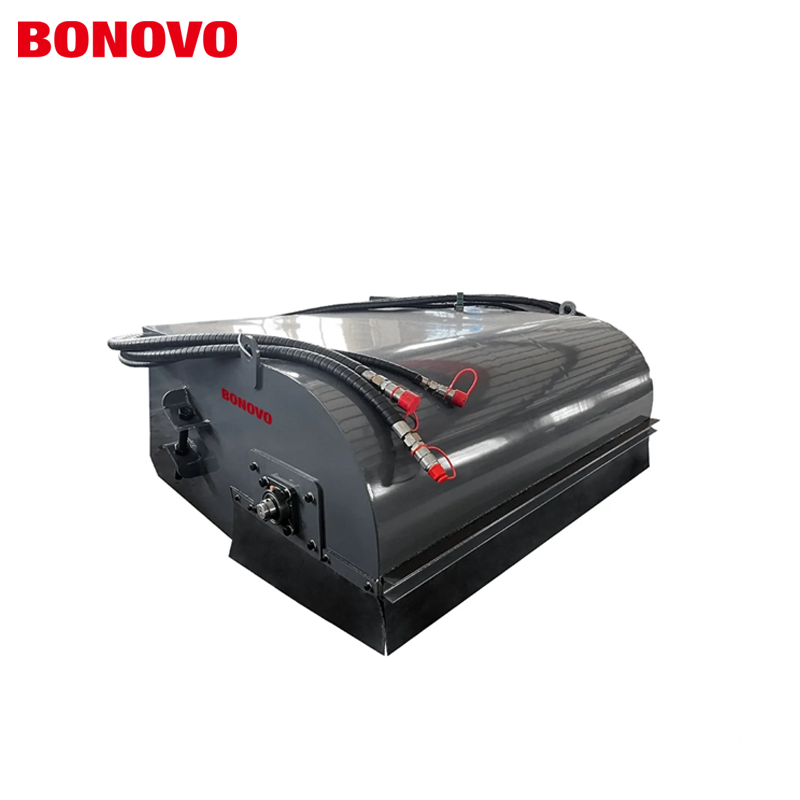In various engineering operations and site cleaning work, the excavator sweeper has become a powerful assistant to improve efficiency. Proper use of it can save manpower while quickly achieving large-area cleaning. The following will introduce its usage tips in detail and share actual cases.
I. Usage Tips
(I) Pre-operation inspection
Mechanical component inspection: Before using the excavator sweeper each time, carefully check the wear of the sweeper's bristles, which is related to the "timing of excavator sweeper bristle replacement". If the bristles are worn by more than one-third, it is recommended to replace them in time to avoid affecting the cleaning effect. At the same time, check whether the bolts at the connection parts are tightened to prevent the parts from loosening or even falling off during the operation, causing safety accidents. For example, a construction team did not check the loose bolt problem, which caused the sweeper to suddenly fall off during operation and smashed nearby construction equipment.
Hydraulic system inspection: The hydraulic system is the power source of the excavator sweeper and is crucial. Check whether the hydraulic oil level is within the normal range and whether the oil quality is good. This is the key content of the "Maintenance Points of the Hydraulic System of the Excavator Sweeper". If the oil level is too low, add hydraulic oil that meets the specifications in time; if the oil is turbid or contains impurities, it needs to be filtered or replaced. In addition, check whether the hydraulic pipeline is damaged or leaking. If a problem is found, repair it immediately to avoid affecting the progress of the operation due to hydraulic system failure.
(II) Operation process
Adjust the angle: Flexibly adjust the angle of the excavator sweeper according to different cleaning scenarios, which involves "Angle adjustment skills of excavator sweepers in different sites". When cleaning flat ground, adjust the sweeper to be parallel to the ground, so that the bristles can evenly contact the ground and ensure the consistency of the cleaning effect. When cleaning slopes or areas with a certain slope, adjust the sweeper angle appropriately to fit the slope surface to ensure that every corner can be effectively cleaned. For example, when cleaning the slope of a mine road, by adjusting the angle, the sweeper can clean the gravel and dust on the slope.
Control speed: Reasonable control of the excavator's travel speed is closely related to the working efficiency of the sweeper, that is, "how to control the cleaning speed of the excavator sweeper". If the speed is too fast, the bristles may not be able to fully clean the ground, resulting in omissions; if the speed is too slow, it will affect the overall work progress. Generally speaking, in places with ordinary garbage and a lot of dust, it is more appropriate to maintain a travel speed of 20-30 meters per minute. However, when cleaning harder debris, such as small pieces of masonry, the speed can be appropriately reduced to ensure that the sweeper has enough power to clean up the debris.
(III) Post-operation maintenance
Cleaning equipment: After the operation, clean the excavator sweeper in time. Use a high-pressure water gun to rinse the bristles to remove the dirt, dust and debris attached to it. At the same time, wipe the outer shell and other parts of the sweeper to keep the equipment clean. This not only makes the equipment look good, but also prevents debris from accumulating and corroding the equipment.
Regular maintenance: Regularly perform comprehensive maintenance on the sweeper, including adding lubricating oil to each lubrication point and checking the wear of the transmission parts. Generally, every 50-100 hours of work, a deep maintenance is performed and wearing parts are replaced to ensure that the equipment is always in good working condition.
II. Case sharing
(I) Cleaning of construction sites
A large construction site generated a large amount of construction waste and dust during the construction process, which seriously affected the surrounding environment and the health of construction workers. After using the excavator sweeper, the cleaning efficiency was greatly improved, highlighting the "advantages of excavator sweepers in construction sites". Construction workers adjusted the sweeper angle according to the site conditions, first cleared large pieces of bricks and other debris to the designated area, and then cleaned the ground at a suitable speed. The site that originally required more than a dozen workers to spend a whole day to clean, after using the excavator sweeper, only one operator was needed to complete the cleaning work within two hours, greatly improving the cleaning efficiency of the construction site, and also reducing labor costs.
(II) Snow cleaning of municipal roads
In the northern winter, snow cleaning of municipal roads is a difficult task. A certain city uses an excavator sweeper to clean snow, reflecting the "role of excavator sweepers in snow cleaning of municipal roads". Replace the special bristles with a rubber scraper suitable for snow removal, adjust the angle, and the excavator sweeper quickly pushes the snow on the road to the roadside. During the cleaning process, flexibly control the speed according to the width of the road and the thickness of the snow. For narrow streets, reduce the speed to ensure the cleaning effect; on wide main roads, increase the speed appropriately. In this way, the city can clear the main roads in a short time after snowfall, ensuring smooth traffic and reducing the incidence of traffic accidents caused by snow.
By mastering the above usage skills and drawing on the successful experience in actual cases, you can better play the role of the excavator sweeper and improve the cleaning efficiency of various sites.

